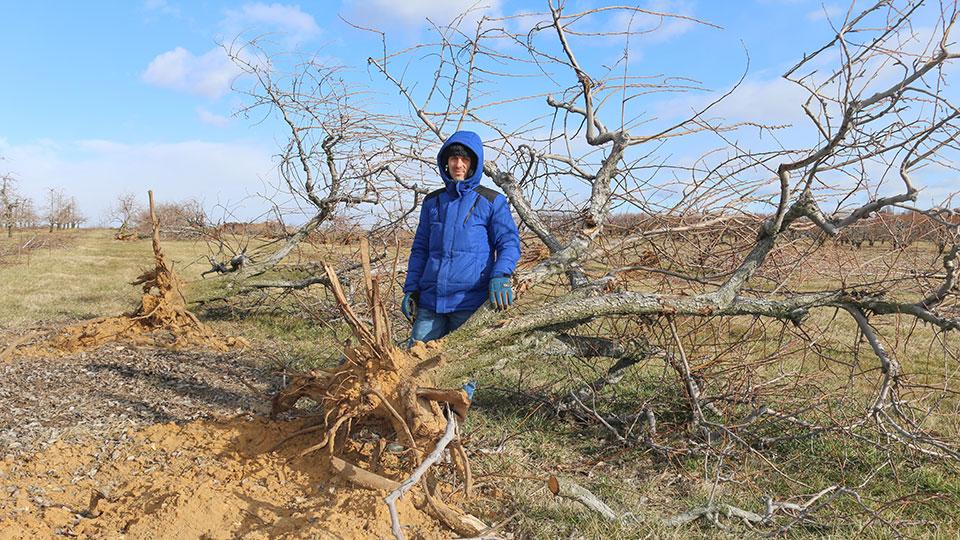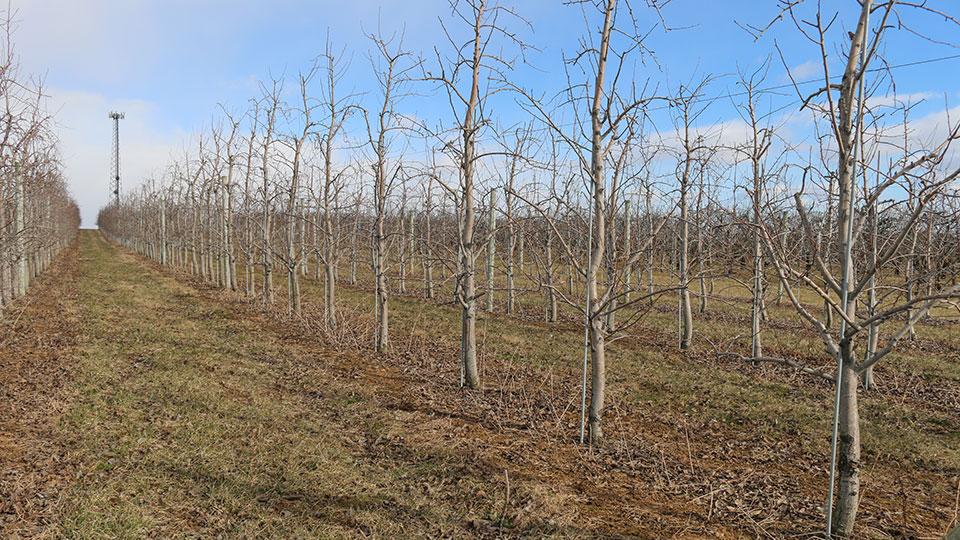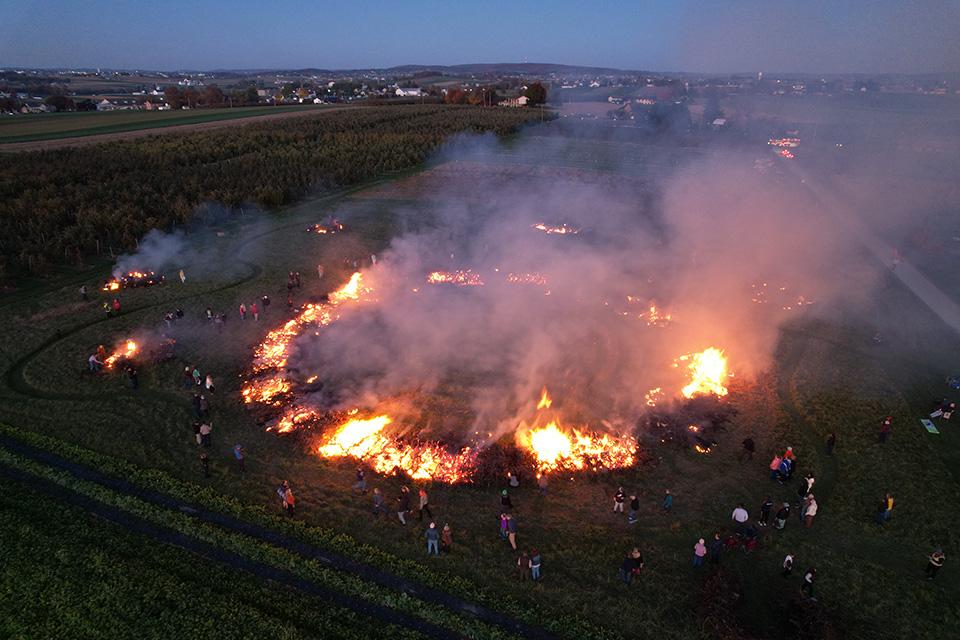The ‘Bartlett Paradox’: Will the Popular Pear Variety Join the High-Density Club?

Clair Kauffman (left) would prefer to include ‘Bartlett’ pear trees in his successful high-density system. Unfortunately, fire blight has either killed off or forced the removal (as shown here) of most of Kauffman’s older ‘Bartlett’ trees.
Photo by Thomas Skernivitz
The air is full of stories, even those of fallen fruit trees. Clair Kauffman grows apples, pears, and cherries at his farm in the heart of Pennsylvania Dutch Country. Some trees are old, some are new, some are long gone. While he takes pride in constantly adding chapters to his own cutting-edge career — the latest of which centers on high-density pear growing — Kauffman wants everyone to remember departed trees such as his.
Last spring, he and artist Rhonda Hershey Ike built a labyrinth and meditative space on the Ronks, PA, property of Kauffman Orchards. With 180 retired apple trees laid along its circumference, “Returning: An Earth Art Installation” spanned 100 feet in diameter.
On Oct. 29, in a season-ending public celebration, the circle of dead ‘Ginger Golds’ was set aflame, thus “returning them to the earth.” Kauffman reflected on the event, writing the 445-word “Eulogy for the Apple Trees” (see sidebar below).
“The land and the trees: They give us so much. They sustain us. They literally keep us alive,” Kauffman says. “As a farmer, it was my way to honor that and maybe call other people to notice as well and not walk by as if they didn’t exist.”
RISKY BUSINESS
Unlike ‘Ginger Gold’ apples, which have fallen in popularity, ‘Bartlett’ pears remain the most commonly grown pear in the U.S. and most countries outside of Asia. So it would appear to be the least likely of fruit trees to be eulogized any time soon.
But ‘Bartlett’ trees have been falling by the wayside at Kauffman Orchards despite being a staple for decades at the fifth-generation farm. The primary reason: death by fire blight. Just as impactful: No one who specializes in high-density architecture, such as Clair Kauffman, wants their investment infected via the presence of trees that are susceptible to a devastating disease.
“The ‘Bartlett’ story, for us, is a little bit of a conundrum,” Kauffman says. “It is still what the customer wants and knows. The transition to teach people that there are just as good pear varieties out there is a really slow process.”
Kauffman likens the situation to that of ‘Redhaven’ peaches, which he still grows to accommodate his retail base. “Everybody wants ‘Redhaven’ even though there are many varieties that are as good or better than ‘Redhaven’ these days,” he says. “But that’s what has stuck in their mind the last three decades.”
Public demand aside, the decision to push out all but two rows of conventionally grown ‘Bartlett’ trees has been an easy one for Clair Kauffman. “Look at the space between these trees. There are so many empty spots. That was because of fire blight,” Kauffman says. “Those were all ‘Bartletts’. As this block aged, there was less and less production and more and more tree mortality.”
DOUBLE-WHAMMY
In retrospect, Kauffman absolves his old ‘Bartletts’ of much guilt. Two contributing factors likely exacerbated their disease susceptibility, he says.
“We had ‘Ginger Gold’ on M26 [rootstock] right next to them, and ‘Ginger Gold’ and M26 are fire blight magnets. So we think we had a com-pounding problem,” Kauffman says. “They were sharing inoculum. It was kind of like, ‘Hey, we’re all here in the hospital together, let’s just all get sick.’”
On top of that, because of all the inoculum and disease pressure, the ‘Bartletts’ developed antibiotic resistance, according to Kauffman.
“But interestingly, the last four or five years we’ve had very little problems in our ‘Bartlett’ block,” he says. “Some new management practices have come along over the years that might be some of it. It’s also maybe just getting to the point of getting past that antibiotic resistance, and it’s working well again. We don’t know. Maybe it’s just having gotten rid of the ‘Ginger Gold’.”

What a successful high-density pear planting looks like at Kauffman Orchards.
Photo by Thomas Skernivitz
SECOND CHANCES
One thing Clair Kauffman does know these days is that his high-density pear system has prospered since being planted in 2015. Covering 2 acres are several newer varieties: ‘Blake’s Pride’, ‘Harrow Crisp’, ‘Harrow Sweet’, ‘Harrow Delight’, ‘Magness’, ‘Potomac’, ‘Seckel’, ‘Sunrise’, and ‘Shenandoah’. Each is planted on OHxF 87 or OHxF 97 rootstock.
“In the long run, my challenge is going to be keeping these things at this shape,” Kauffman says. “They are going to want to grow out.”
Things are going so well for Kauffman that the next step of his high-density adventure will likely include a plot twist: He is going to give ‘Bartlett’ another shot in 2024.
Word has spread throughout the region that at least one smaller operation in Lancaster County, White Oak Nursery, has been propagating a ‘Bartlett’ that appears to be more resistant to fire blight, Kauffman says. Several such trees have remained unscathed for several years after having been in a block that was afflicted by the disease.
“They seem to be holding true to their fire blight resistance, so I’m going to stick my neck out a little bit,” Kauffman says. “I ordered trees for two more rows to extend this block. I’ll push some cherries out here and extend this pear block two more rows.
“I’ll go into it with my eyes wide open. If problems begin, I’ll probably just top graft onto something else. But as it turns out, I’m also planting them on the downwind side of the block. If they do end up getting fire blight, there is a little bit less chance of that spreading through the block.”
Therein lies the gamble that accompanies ‘Bartlett’.
“We can sell a ‘Bartlett’ for a good $5 more a box just because the customers have to have it. And it’s also an important variety for our retail customers especially,” Kauffman says. “So, with all of those factors, I feel like I want to plant a few more ‘Bartletts’. I probably will try the multileader on those. The more you can reduce vigor, the less susceptible your trees are to fire blight.”
Is it worth the risk? If so, Kauffman and his high-density pear trees will have plenty of stories to tell someday, each with an ending that goes something like this:
“In 2021, looking down these rows, all you could see was pears,” Kauffman says. “We had never seen anything like it in all of our years of producing pears. Just a wall of pears. It was something else.”

Photo courtesy of Kauffman Orchards
Eulogy for the Apple Trees
Hear a eulogy for the trees. The legacy of these trees holds whispers of another way.
The way of generosity, in its purest, most selfless form. Without attachment or negotiation. Giving the best of gifts in spite of less-than-ideal circumstance.
The way of joy-filled being. Not holding on to the inner stories of grievance or complaint or even of wild success. Not chasing the numerous illusions and bobbleheads of the ego — just delighting in being an apple tree, and pouring joy into the great work.
The way of quietness and gentleness, of acceptance for what is. Offering a non-anxious, non-judging presence. A walk in the orchard is always an invitation into the present moment, to be right here, right now.
“If these trees could talk,” we say. Yet they do. Their storied lives ask us to pay attention to the earth, to our own stories, and to where our stories meet — in the air we breathe and in the ground beneath our feet.
They ask just to give attention to the past and to the future. Before this work of art, an orchard. A hundred years ago before the orchard, a dairy farm and tobacco land. Before that, our memory fades to the imagination of a forested ridge tended by its first peoples. This spring, at the time this work of art was being made, my son found an arrowhead protruding from a bit of open ground not 100 yards from here. A quiet yet persistent witness to a time when this land offered abundant food of kinds we now either despise or forget and was home to people to whom we’ve done the same.

Photo courtesy of Kauffman Orchards
The stories quietly held by the land and the trees tell of life, and also death. Of freedom and wildness, and also of captivity and domestication. Of joy and flourishing, and also of grief and brokenness. It’s our story too, this paradox in the land and trees.
And what stories will be told 100 years from now? And how will the stories of the land and the trees be ours also? Will we have learned to live at peace with ourselves and with the land and what it requires of us? Or will we have been so slow to learn that this land finally becomes a mere witness to the manifest failures of industrial farming?
If these trees have a dying wish, I think it is this. Stay and listen. Wait a while. Give full attention inward and outward. Learn their way. Never forget their life, their joy, their stories, their legacy. Until patience has her perfect way with you and yields in you the fruit of wisdom.
— Clair Kauffman










